六年级上册英语期中知识点归纳
- 格式:docx
- 大小:15.34 KB
- 文档页数:2
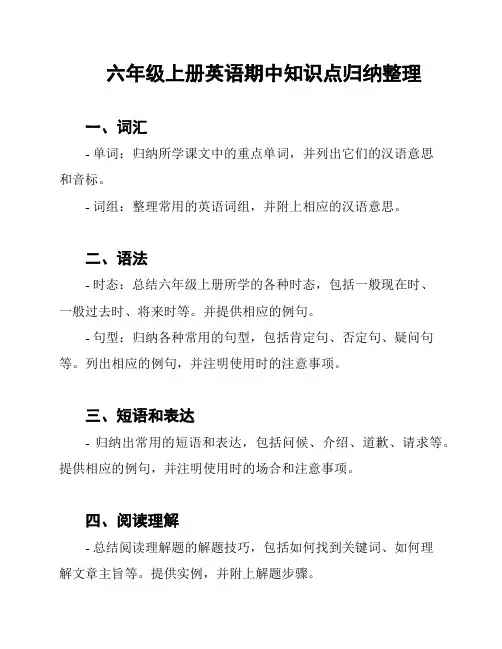
六年级上册英语期中知识点归纳整理
一、词汇
- 单词:归纳所学课文中的重点单词,并列出它们的汉语意思
和音标。
- 词组:整理常用的英语词组,并附上相应的汉语意思。
二、语法
- 时态:总结六年级上册所学的各种时态,包括一般现在时、
一般过去时、将来时等。
并提供相应的例句。
- 句型:归纳各种常用的句型,包括肯定句、否定句、疑问句等。
列出相应的例句,并注明使用时的注意事项。
三、短语和表达
- 归纳出常用的短语和表达,包括问候、介绍、道歉、请求等。
提供相应的例句,并注明使用时的场合和注意事项。
四、阅读理解
- 总结阅读理解题的解题技巧,包括如何找到关键词、如何理
解文章主旨等。
提供实例,并附上解题步骤。
五、写作技巧
- 整理六年级上册所学的写作技巧,包括写日记、写信、写卡片等。
提供相应的模板和例句,并提供写作时的一些建议。
六、口语练
- 提供一些口语练的例题,包括日常对话场景、问候等。
提供参考回答,并提供一些练的方法和建议。
以上是《六年级上册英语期中知识点归纳整理》的大纲,希望对你的学习有所帮助!。
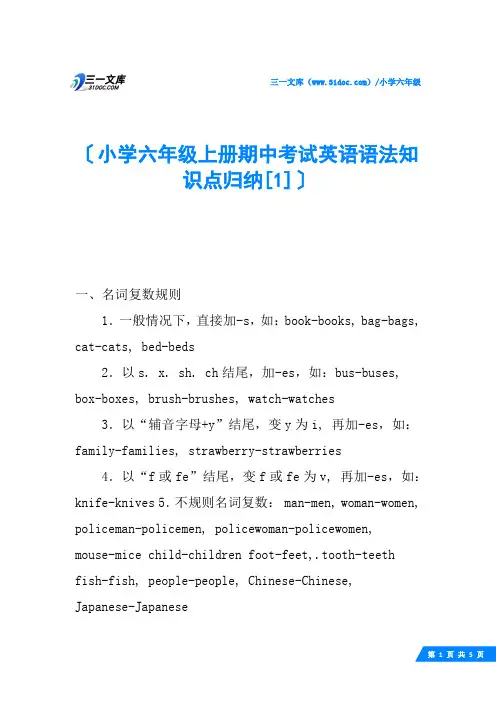
三一文库()/小学六年级〔小学六年级上册期中考试英语语法知识点归纳[1]〕一、名词复数规则1.一般情况下,直接加-s,如:book-books, bag-bags, cat-cats, bed-beds2.以s. x. sh. ch结尾,加-es,如:bus-buses, box-boxes, brush-brushes, watch-watches3.以“辅音字母+y”结尾,变y为i, 再加-es,如:family-families, strawberry-strawberries4.以“f或fe”结尾,变f或fe为v, 再加-es,如:knife-knives 5.不规则名词复数: man-men, woman-women, policeman-policemen, policewoman-policewomen,mouse-mice child-children foot-feet,.tooth-teethfish-fish, people-people, Chinese-Chinese,Japanese-Japanese二、一般现在时1.一般现在时表示经常或习惯性的动作,也可表示现在的状态或主语具备的性格和能力。
2.一般现在时中,没有be动词和情态动词,主语为第三人称单数的肯定句,动词要按规则加上s,主语是非第三人称单数的肯定句,动词用原形。
3.在一般现在时中,句中有be动词或情态动词时,否定句在be动词和情态动词后加not,一般疑问句将be动词或情态动词放在句首。
4.在一般现在时中,句中没有be动词或情态动词时,主语为第三人称单数的否定句在动词前加does+not (doesn‘t),一般疑问句在句首加does,句子中原有动词用原形;主语为非第三人称单数,否定句用do+not (don’t),一般疑问句在句首加do,句子中动词用原形。
动词+s的变化规则1.一般情况下,直接加-s,如:cook-cooks, milk-milks2 .以s. x. sh. ch. o结尾,加-es,如:guess-guesses, wash-washes, watch-watches, go-goes3.以“辅音字母+y”结尾,变y为i, 再加-es,如:study-studies 三、现在进行时1.现在进行时表示现在正在进行或发生的动作,也可表示当前一段时间内的活动或现阶段正在进行的动作。
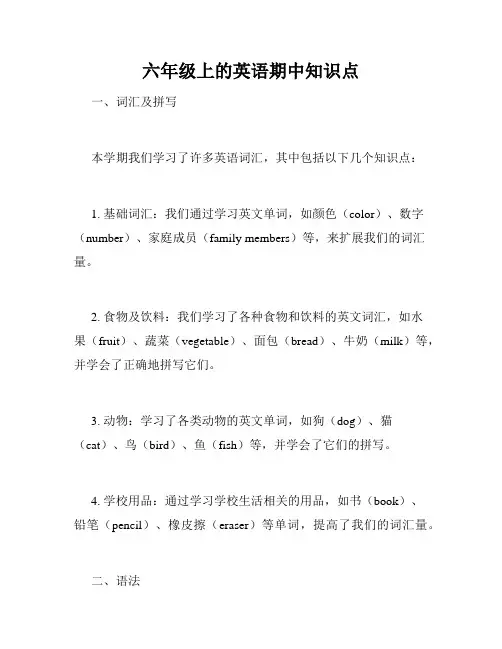
六年级上的英语期中知识点一、词汇及拼写本学期我们学习了许多英语词汇,其中包括以下几个知识点:1. 基础词汇:我们通过学习英文单词,如颜色(color)、数字(number)、家庭成员(family members)等,来扩展我们的词汇量。
2. 食物及饮料:我们学习了各种食物和饮料的英文词汇,如水果(fruit)、蔬菜(vegetable)、面包(bread)、牛奶(milk)等,并学会了正确地拼写它们。
3. 动物:学习了各类动物的英文单词,如狗(dog)、猫(cat)、鸟(bird)、鱼(fish)等,并学会了它们的拼写。
4. 学校用品:通过学习学校生活相关的用品,如书(book)、铅笔(pencil)、橡皮擦(eraser)等单词,提高了我们的词汇量。
二、语法本学期我们学习了以下几个语法知识点:1. 一般现在时:我们学会使用一般现在时来描述日常的活动和习惯,如主语+动词(第三人称单数形式),例如:He eats an apple every day(他每天吃一个苹果)。
2. 疑问句与否定句:我们学习了如何构造疑问句和否定句。
构造疑问句时需要在句首加助动词do/does,并调整主谓语序;构造否定句时需要在动词前加上否定副词not。
3. 介词的用法:我们学习了一些常用的介词,如in、on、under 等,并学会了它们在句子中的正确用法。
4. 形容词比较级:学习了形容词比较级的构成方式和用法。
当我们想要比较两个事物的大小、高矮等,可以使用形容词比较级,如taller、more beautiful等。
三、阅读理解在阅读理解方面,我们通过阅读英文短文来提高我们的阅读能力和理解能力。
在六年级上学期,我们学习了以下几个方面:1. 找出关键词:通过阅读短文,我们学会了找出关键词,帮助我们理解整个故事情节。
2. 推断含义:通过短文中的上下文线索,我们学会了推断词义的方法,从而更好地理解短文的内容。
3. 回答问题:通过阅读理解题,我们学会了如何准确地根据问题从短文中找到答案,并培养了细心阅读的习惯。
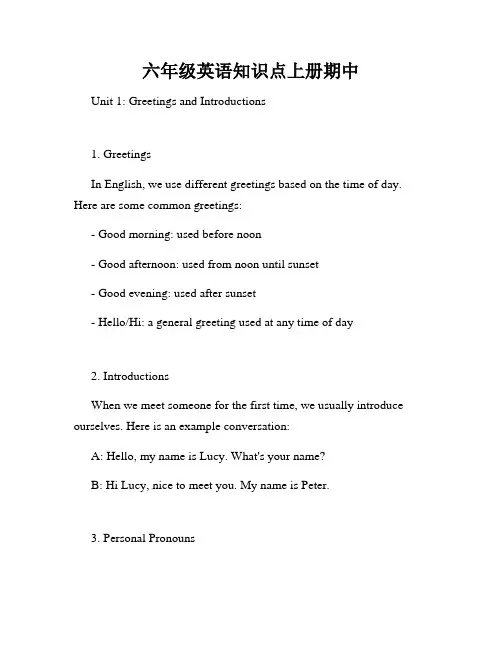
六年级英语知识点上册期中Unit 1: Greetings and Introductions1. GreetingsIn English, we use different greetings based on the time of day. Here are some common greetings:- Good morning: used before noon- Good afternoon: used from noon until sunset- Good evening: used after sunset- Hello/Hi: a general greeting used at any time of day2. IntroductionsWhen we meet someone for the first time, we usually introduce ourselves. Here is an example conversation:A: Hello, my name is Lucy. What's your name?B: Hi Lucy, nice to meet you. My name is Peter.3. Personal PronounsPersonal pronouns are used to replace nouns when referring to people. Here are the personal pronouns in English:- I, me: used when referring to oneself- You: used when referring to the person being spoken to- He, she, it: used when referring to someone or something else- We, us: used when referring to a group that includes oneself- They, them: used when referring to more than one person or thing4. Sentence StructureIn English, a simple sentence consists of a subject, a verb, and an object. For example:- Lucy (subject) likes (verb) ice cream (object).5. NumbersIt is important to know how to count in English. Here are the numbers from 1 to 10:- One, two, three, four, five, six, seven, eight, nine, ten.Unit 2: School Life1. School SubjectsIn school, we learn different subjects. Here are some common school subjects in English:- English: the study of the English language- Math: the study of numbers, calculations, and equations- Science: the study of the natural world- History: the study of past events- Geography: the study of the Earth and its features2. Classroom ObjectsIn a classroom, we use various objects. Here are some common classroom objects in English:- Desk: a piece of furniture where students sit and work- Chair: a piece of furniture used for sitting- Book: a written or printed work consisting of pages- Pen: a writing instrument- Pencil: a writing instrument with a graphite core3. Daily RoutineWe all have a daily routine. Here is an example of a typical daily routine:- Wake up- Get dressed- Eat breakfast- Go to school- Attend classes- Have lunch- Study/do homework- Play sports/engage in extracurricular activities- Eat dinner- Relax/watch TV- Go to bed4. TimeIt is important to know how to tell time in English. Here are some useful phrases:- What time is it?- It's 8 o'clock.- It's half-past 9.Unit 3: Family and Friends1. Family MembersIn English, we have different words to describe family members. Here are some common family members:- Mother: a female parent- Father: a male parent- Sister: a female sibling- Brother: a male sibling- Grandmother: the mother of one's parent- Grandfather: the father of one's parent2. Describing PeopleWe can use adjectives to describe people's physical appearance and personality. Here are some examples:- Tall: higher in height- Short: lower in height- Friendly: kind and sociable- Funny: causing laughter3. Hobbies and InterestsWe all have hobbies and interests. Here are some common hobbies and interests in English:- Reading: enjoying books and literature- Dancing: moving rhythmically to music- Playing sports: engaging in physical activities- Painting: creating art with colors and brushes- Playing musical instruments: expressing oneself through music4. Feelings and EmotionsIn English, we use different words to express our feelings and emotions. Here are some common words:- Happy: feeling joy or contentment- Sad: feeling sorrow or unhappiness- Excited: feeling eager or enthusiastic- Nervous: feeling anxious or worriedThis is a brief overview of some of the knowledge points covered in the first half of the 6th-grade English curriculum. Remember to practice these concepts regularly to improve your English skills. Good luck!。
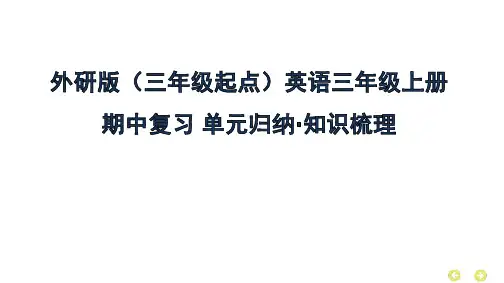
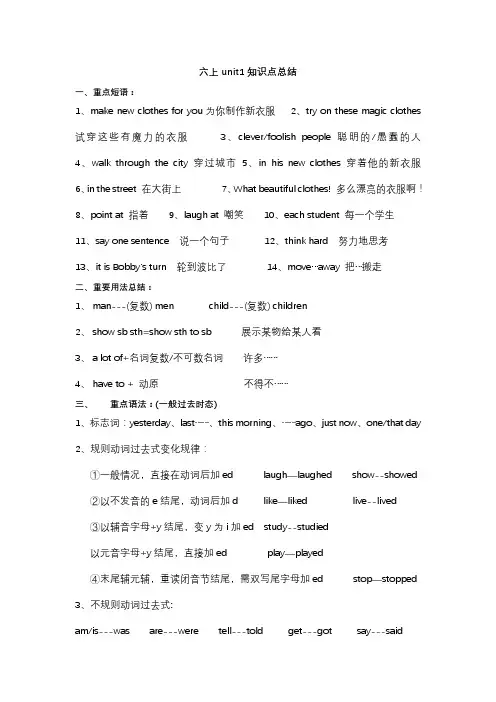
一、重点短语:1、make new clothes for you为你制作新衣服2、try on these magic clothes 试穿这些有魔力的衣服3、clever/foolish people 聪明的/愚蠢的人4、walk through the city 穿过城市5、in his new clothes 穿着他的新衣服6、in the street 在大街上7、What beautiful clothes! 多么漂亮的衣服啊!8、point at 指着9、laugh at 嘲笑10、each student 每一个学生11、say one sentence 说一个句子12、think hard 努力地思考13、i t is Bobby’s turn 轮到波比了14、move…away把…搬走二、重要用法总结:1、man---(复数) men child---(复数) children2、show sb sth=show sth to sb 展示某物给某人看3、a lot of+名词复数/不可数名词许多……4、have to + 动原不得不……三、重点语法:(一般过去时态)1、标志词:yesterday、last……、this morning、……ago、just now、one/that day2、规则动词过去式变化规律:①一般情况,直接在动词后加ed laugh—laughed show--showed②以不发音的e结尾,动词后加d like—liked live--lived③以辅音字母+y结尾,变y为i加ed study--studied以元音字母+y结尾,直接加ed play—played④末尾辅元辅,重读闭音节结尾,需双写尾字母加ed stop—stopped3、不规则动词过去式:am/is---was are---were tell---told get---got say---said一、重点短语:1、a parrot show 一场鹦鹉秀2、fly kites high 风筝飞的高3、in the sky 在天空中4、black clouds 乌云5、what a day ! 多么糟糕的一天!6、in the playground 在操场上7、well done 干得好8、climb up 爬上9、hold onto 抓紧10、fly away 飞走11、have a picnic 野餐12、watch a film 看电影13、do the housework 做家务14、What happened? 出什么事了?二、重要用法总结:1、be/become + sunny / rainy / windy / cloudy2、“乘坐某种交通工具”:by+交通工具(放句末),take+a/the+交通工具(放句中)3、“该是做某事的时间了”:I t’s time for + 名词,It’s time to + 动原4、bread 和honey 是不可数名词5、“……怎么了?“:W hat’s the matter ( w ith sb ) ?= What’s wrong ( with sb ) ?6、“想要做某事“:want / would like +to+动原7、rain “下雨“动词(rains / rained / be raining )rain “雨水“不可数名词rainy “多雨的”形容词( be rainy )8、“天气怎么样”:一般现在时态:W hat’s the weather like ?一般过去时态:What was the weather like ?三、重点语法:【一般过去时态】1、标志词:last , ago , yesterday , this morning , just now , one day/that day2、动词形式:用动词过去式(规则动词过去式和不规则动词过去式)3、句型:肯定句:用(was/were)、(实义动词过去式)否定句:用(wasn’t/weren’t)、(didn’t+动原)一般疑问句:用(Was/Were开头)、(Did开头)【didn’t和Did 后用动原】4、默写下列不规则动词过去式:become—became bring—brought can—could fly—flewgo—went see—saw take—took lose—lostfind—found have—had do—did give--gave六上unit3知识点总结一、重点短语:1、come back to school 回到学校2、the National Day holiday 国庆节假期3、many interesting things 许多有趣的东西4、It was great fun 真有趣5、pick some oranges 采摘一些橘子6、go fishing 去钓鱼7、catch a big fish 抓住一条大鱼8、come home late 回家很晚9、Shanghai Museum 上海博物馆10、Great Wall 长城11、Palace Museum 故宫12、Summer Palace 颐和园13、Tian’anmen Square 天安门广场14、fashion show 时装秀15、go well 进展顺利16、at first 开始,最初17、heavy rain 大雨18、What great fun! 多么有趣啊!19、a lot of=lots of 许多20、on the farm 在农场21、go for the holiday 度假22、b e excited about… 对…感到兴奋激动二、重要用法总结:1、“问某人关于某事“ask sb about sth2、“激动的,兴奋的“excited 修饰人,exciting 修饰物。
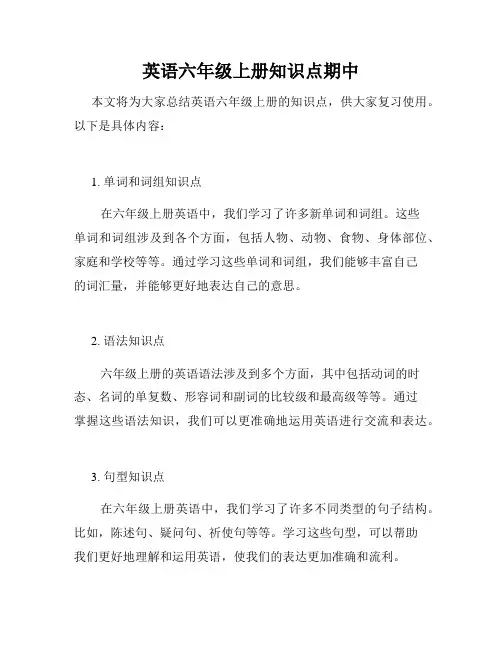
英语六年级上册知识点期中本文将为大家总结英语六年级上册的知识点,供大家复习使用。
以下是具体内容:1. 单词和词组知识点在六年级上册英语中,我们学习了许多新单词和词组。
这些单词和词组涉及到各个方面,包括人物、动物、食物、身体部位、家庭和学校等等。
通过学习这些单词和词组,我们能够丰富自己的词汇量,并能够更好地表达自己的意思。
2. 语法知识点六年级上册的英语语法涉及到多个方面,其中包括动词的时态、名词的单复数、形容词和副词的比较级和最高级等等。
通过掌握这些语法知识,我们可以更准确地运用英语进行交流和表达。
3. 句型知识点在六年级上册英语中,我们学习了许多不同类型的句子结构。
比如,陈述句、疑问句、祈使句等等。
学习这些句型,可以帮助我们更好地理解和运用英语,使我们的表达更加准确和流利。
4. 阅读和听力理解知识点在六年级上册英语中,我们进行了大量的阅读和听力训练。
通过这些训练,我们可以提高自己的阅读和听力理解能力,更好地理解英语文章和对话,并能够从中获取所需的信息。
5. 写作知识点写作是英语学习的重要组成部分。
在六年级上册英语中,我们学会了如何写作短文和信件。
通过这些写作练习,我们可以提高自己的写作能力,能够更好地表达自己的观点和想法。
6. 口语表达知识点英语口语表达是我们学习英语的重要目标之一。
通过六年级上册英语的学习,我们不仅学会了很多日常用语和口语表达,还能够进行简单的对话和交流。
通过对六年级上册英语知识点的总结,我们可以更好地复习和巩固所学知识,并为下学期的学习打下坚实的基础。
祝大家在英语学习中取得更好的成绩!。
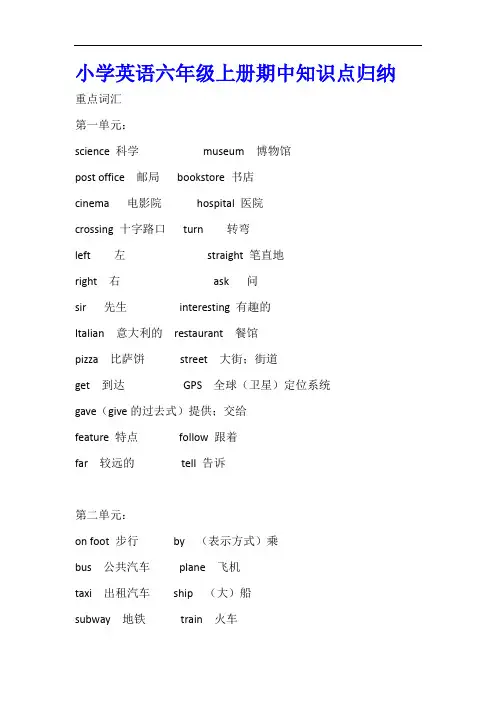
小学英语六年级上册期中知识点归纳重点词汇第一单元:science 科学museum 博物馆post office 邮局bookstore 书店cinema 电影院hospital 医院crossing 十字路口turn 转弯left 左straight 笔直地right 右ask 问sir 先生interesting 有趣的Italian 意大利的restaurant 餐馆pizza 比萨饼street 大街;街道get 到达GPS 全球(卫星)定位系统gave(give的过去式)提供;交给feature 特点follow 跟着far 较远的tell 告诉第二单元:on foot 步行by (表示方式)乘bus 公共汽车plane 飞机taxi 出租汽车ship (大)船subway 地铁train 火车slow 慢的down 减少;降低slow down 慢下来stop 停下Mrs 夫人early 早到的helmet 头盔must 必须wear 戴attention 注意pay attention to 注意traffic 交通traffic lights 交通信号灯sled 雪橇fast 快的ferry 轮渡Germany 德国Munich 慕尼黑(德国城市)Alaska 阿拉斯加州(美国州名)Scotland 苏格兰Papa Westray 帕帕韦斯特雷岛第三单元:visit 拜访visit my grandparents去看望我的(外)祖父母film 电影see a film 看电影trip 旅行take a trip 去旅行supermarket 超市go to the supermarket 去超市evening 晚上;傍晚tonight 在今晚tomorrow 明天next week 下周dictionary 词典comic 滑稽的comic book (儿童的)连环画册word 单词word book 单词书postcard 名信片lesson 课space 太空travel (尤指长途)旅行half 一半price 价格Mid-Autumn Festival 中秋节together 一起get together 聚会mooncake 月饼poem 诗moon 月亮重点句型第一单元:1.问“在哪儿”:Where is the museum shop?博物馆的商店在哪儿?(1)It's near the door.在大门附近。
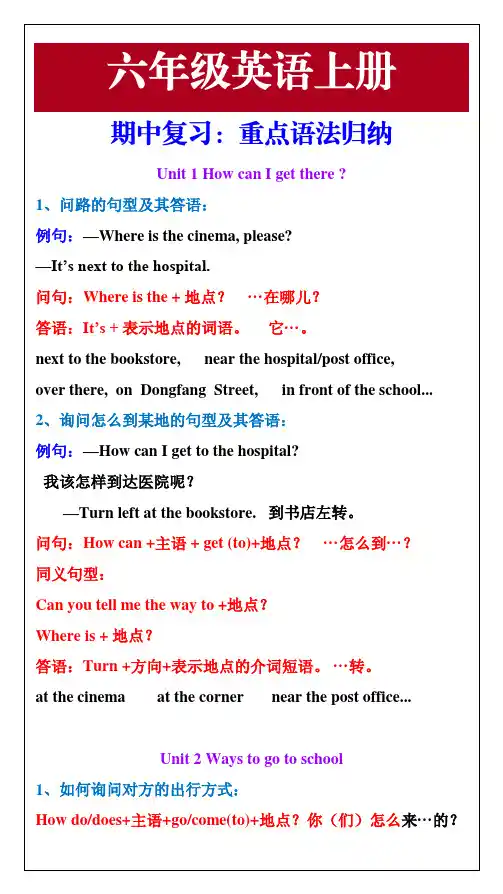
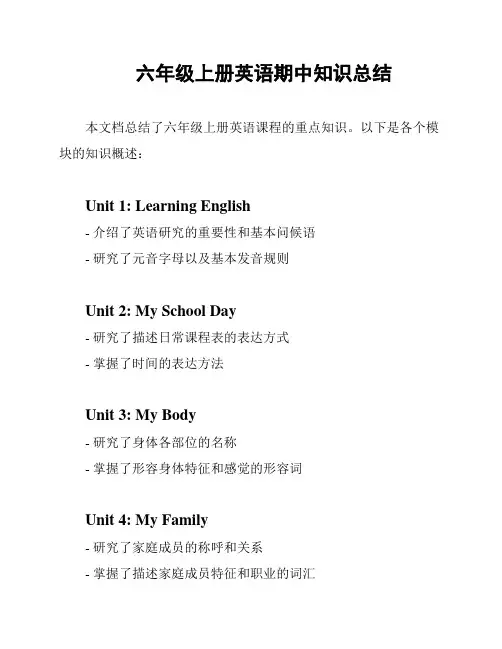
六年级上册英语期中知识总结
本文档总结了六年级上册英语课程的重点知识。
以下是各个模块的知识概述:
Unit 1: Learning English
- 介绍了英语研究的重要性和基本问候语
- 研究了元音字母以及基本发音规则
Unit 2: My School Day
- 研究了描述日常课程表的表达方式
- 掌握了时间的表达方法
Unit 3: My Body
- 研究了身体各部位的名称
- 掌握了形容身体特征和感觉的形容词
Unit 4: My Family
- 研究了家庭成员的称呼和关系
- 掌握了描述家庭成员特征和职业的词汇
Unit 5: My Home
- 研究了家居用品的名称
- 掌握了描述家居位置和房间功能的语句
Unit 6: My School
- 介绍了自己的学校及其地理位置
- 研究了描述学校设施和活动的词汇
总结
六年级上册英语课程涵盖了研究英语的重要性、日常课表、身体各部位、家庭成员、家居用品和学校生活等方面的知识。
通过研究这些内容,我们能够更好地表达自己的想法和交流。
希望同学们能够继续努力,在接下来的学期中取得更好的成绩!
以上是对六年级上册英语期中知识的总结。
祝大家研究进步!。
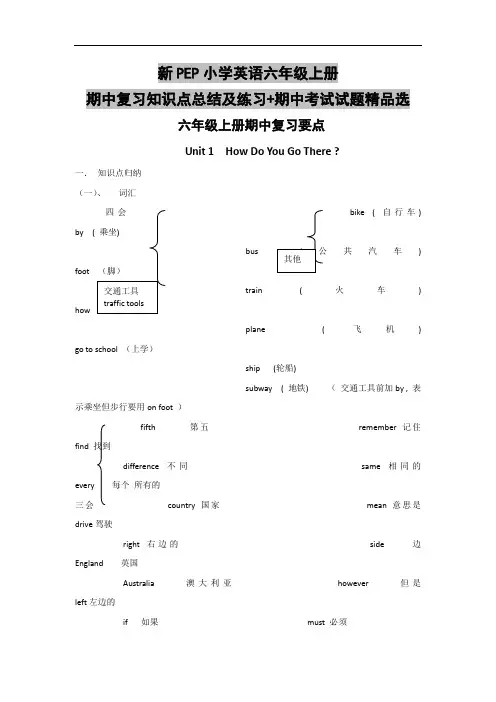
新PEP小学英语六年级上册期中复习知识点总结及练习+期中考试试题精品选六年级上册期中复习要点Unit 1 How Do You Go There ?一.知识点归纳(一)、词汇bike ( 自行车) bybus 共汽车) foottrain (火车) howplane ( 飞机) go to school (上学)ship (轮船)subway ( 地铁) (交通工具前加by , 表示乘坐但步行要用on foot )fifth 第五remember记住find 找到difference不同same相同的every 每个所有的三会country 国家mean意思是drive驾驶right右边的side 边England 英国Australia 澳大利亚however 但是left左边的if 如果must 必须(二)、重点句型①询问交通方式用疑问代词how⏹——How do you go to school ? 你怎样去上学?—— I go to school on foot . 我走路去上学。
⏹—— How do you go to Canada ? 你怎么去加拿大。
——I go by plane . 我坐飞机去。
⏹—— How does your father go to work ? 你父亲怎样去上班?——He goes to work by subway . 他坐地铁去上班。
②询问地点,用疑问代词where⏹——Where is your home ? 你家在哪里?——It’s near the post office . 在邮局旁边。
⏹——Where are the teachers ? 老师们在哪儿?——They are in the teacher’s office . 在老师的办公室。
③问路⏹——How can I get to Zhongshan Park ? 我怎么去中山公园?——You can go by the No.1 bus.You cantake the No .1 bus④交通规则(traffic rules )⏹Stop at a red light . 红灯停⏹Wait at a yellow light . 黄灯停⏹Go at a green light . 绿灯行⏹In China and the US , drivers drive on the right side of the road .在中国和美国,司机靠右行驶。
新版人教版六年级英语上册期中知识点总
结
本文档旨在总结新版人教版六年级英语上册的期中考试知识点。
以下是重点内容的概要:
1. 词汇知识
- 学生将掌握并熟练运用单词和短语的拼写、发音和词义。
- 学生应熟悉常用的动词、名词、形容词和副词,并能正确运
用在句子中。
2. 语法知识
- 学生将研究并掌握各种基本句型以及基本的语法规则,例如
肯定句、否定句、一般疑问句和特殊疑问句的构成和用法。
- 学生将学会正确运用时态、语态和语气等语法要点。
3. 阅读理解
- 学生将练阅读各类短文并回答相关问题。
- 学生将学会从文章中提取信息、理解文章主旨以及推断上下
文中的未知词语的意思。
4. 口语表达
- 学生将练口语交流并改进发音和语调。
- 学生将能够运用已学的词汇和语法,进行简单的问答和对话。
以上是新版人教版六年级英语上册的期中考试知识点总结。
希
望同学们能够通过认真研究和复,取得优异的成绩。
如有任何问题,请随时与老师进行沟通和交流。
祝同学们学业进步!。
六年级上册英语期中知识点回顾
本文档旨在回顾六年级上册英语期中的知识点,帮助同学们进行复和巩固。
以下是各个知识点的简要回顾:
1. 词汇
- 单词的拼写和发音
- 常用的动词、形容词和副词
- 数字、时间和日期的表达
2. 语法
- 一般现在时和一般过去时的用法
- 名词单复数的形式变化
- 人称代词的用法
- 疑问句和否定句的构造
3. 句型
- 基本的陈述句结构
- 祈使句的构造和用法
- 常用的疑问句句型
4. 阅读理解
- 根据短文回答问题
- 根据提示填空或选择正确答案
- 根据图片理解和描述
5. 听力技巧
- 听懂对话和短文,并选择正确答案
- 听写单词和句子
- 根据听到的内容回答问题
6. 写作
- 简单的日常生活写作,如介绍自己或家人、描述喜欢的事物等
- 表达对某事物的观点和喜好
7. 口语表达
- 基本的问候和自我介绍
- 日常用语和常见场景下的口语表达
- 与他人进行简单对话的技巧
以上是六年级上册英语期中知识点的简要回顾,希望同学们在复中能够掌握这些知识,并在期中考试中取得好成绩。
祝愿大家研究顺利!。
新版人教PEP 小学英语六年级上册期中
测试重点知识整理
1. 单词知识
- 基础词汇:掌握课本单元中出现的所有单词,并能正确拼写和运用。
- 特殊名词:对于一些常见的特殊名词,例如职业、动物等,要了解其英文表达及相应的词汇。
2. 语法知识
- 一般现在时:掌握一般现在时的用法,能正确运用句子结构和动词形式。
- 祈使句:了解祈使句的用法,能正确表达各种祈使句。
- 一般过去时:理解一般过去时的用法,能正确使用过去时态的动词形式。
- 现在进行时:了解现在进行时的用法,能正确使用进行时的动词形式。
3. 句型结构
- 肯定句:能正确构造肯定句,使句子结构完整、通顺。
- 否定句:了解否定句的构成方式,能正确运用否定形式构造句子。
- 一般疑问句:了解一般疑问句的结构,能正确构造疑问句并作出回答。
4. 阅读理解
- 阅读短文:能够理解短文的大意,获取文中的关键信息。
- 理解问题:能够根据所读短文回答相关问题,理解问题的要点并给出准确答案。
以上是本学期上册期中测试的重点知识整理,希望大家能认真复习并加强强化练习,取得优异的成绩。
加油!。
六上英语期中考试归纳Unit1How can I get there?【重点词汇】science科学museum博物馆bookstores书店cinema 电影院hospital医院crossing十字路口turn转弯left左straight笔直地right右post office邮局go straight直走【巧记单词】(一)我的家乡建筑多,快来听我说一说。
science museum真奇妙,里面知识真不少。
到post office把信寄,到bookstore来看书。
到cinema看电影,hospital医生忙。
(二)站在crossing辨方向,左转右转要分清。
turn left向左转,turn right向右转。
直走也要记清楚,直走直走go straight。
【习惯搭配】buy a postcard买一张明信片get there到那儿near the door在大门附近go straight直走next to挨着turn left左转an interesting film一部有趣的电影turn right右转【惯用表达】1.I don't know.我不知道。
2.Follow me,please!请跟着我!3.Excuse me.对不起,打扰一下。
4.Let's go!我们走吧!【重点句型】1.询问某地在哪:-Where is+地名?-It's+方位词+其他.eg:-Where is the post office?邮局在哪儿?-It's near the school.在学校附近。
2.询问如何到达某地:-How can I get to+地名?eg:⑴-How can I get to the school?我怎样才能到达学校?-Go straight and turn left.直走然后左转。
⑵-How can I get to the park?我怎样才能到达公园?-Turn right.The park is in front of thecinema.右转。
六年级英语上册期中重点知识点Unit1一.必听写单词、词组library 图书馆 go straight直行 post office邮局 hospital医院turn left 左转 turn right 右转 cinema 电影院 bookstore 书店science muse科学博物馆 pet hospital 宠物医院crossing 十字路口二:句型:1.Where is the cinema, please? 请问电影院在哪儿?It’s next to the hospital. 在医院的旁边。
2.Excuse me, is there a cinema near here?请问这附近有电影院吗?Yes, there is. /No,there isn’t. 有./没有。
3.How can I get to the hospital? 我该怎样到达医院呢?Take the No.57...积累指引路句型:1. You can take the No.312 bus. 你可乘坐312路公交车去那儿.2. Go straight for three minutes. 向前直走3分钟.3. Turn right/ left at the … 在… 地方向右/ 左转.4. Walk east/ west/ south/ north for … minutes. 朝东/ 西/南/北/ 走…分钟.5.Is it far from here? 离这儿远吗Yes, it is. / No, it isn’t.是的很远/ 不是很远。
Unit 2一、必听单词、词组bike 自行车 by 乘坐 slow down 慢下来 bus 公共汽车foo脚 stop停下 train火车 how怎样 plane飞机go to school 上学 ship 轮船 taxi 出租车 ferry 轮渡sled 雪橇 subway 地铁二、句型:①询问交通方式用疑问代词how1、 How do you go/come to school ? 你怎样去/来上学?I go/come to school on foot . 我走路去/来上学。
六年级上册英语期中知识点归纳
Unit 1 How can I get there ?
一、主要单词:
museum 博物馆bookstore 书店cinema 电影院turn 转弯hospital 医院left 向左post office 邮局science 科学right 向右straight 笔直地crossing 十字路口
二、习惯语搭配:
post office 邮局science museum 科学博物馆pet hospital 宠物医院Italian restaurant 意大利餐馆Beihai Park 北海公园Palace Museum 故宫博物院go straight 直走turn right/left 右/ 左转next to 挨着in front of...在...前面near the park 在公园附近on Dongfang Street 在东方大街上
三、惯用表达式:Excuse me 打扰一下Follow me, please!请跟着我!
四、公式化句型:
1、问路的句型及其答语:问句:Where is the + 地点?···在哪儿?答语:It’s + 表示地点的词语。
它···。
next to the bookstore, near the hospital/post office, over there, on Dongfang Street, in front of the school...
2、询问怎么到某地的句型及其答语:问句:How can + 主语+ get (to)+ 地点?···怎么到···?同义句型:Can you tell me the way to +地点?Where is + 地点?Which is the way to +地点?答语:Turn +方向+表地点的介词短语。
···转。
at the cinema near the post office...
五、例句:Where is the cinema, please? 请问电影院在哪里?It’s next to the hospital. 它与医院相邻。
Turn left at the cinema, then go straight. It’s on the left. 在电影院向左转,然后直行。
它在左边。
Turn left at the bank. 在银行左转。
Unit 2 Ways to go to school
一、主要单词:
by 乘bus 公共汽车on foot 步行plane 飞机taxi 出租车ship(大)船subway 地铁train 火车slow 慢的stop 停下always 总是,一直usually 通常often 经常sometimes 有时候never 从来不
二、习惯语搭配:
by bike/bus/plane/subway/train/ship/taxi/ferry 骑自行车/乘公共汽车/飞机/地铁/火车/船/出租汽车/渡轮
take the No.57 bus乘57路公共汽车on foot步行slow down慢下来pay attention to 注意traffic lights 交通信号灯look right 向右看cross the road 横穿马路get off 下车at home 在家traffic rules 交通规则get to 到达get on 上车be far from…表示离某地远
三、惯用表达式:
Wait!等一等!Hooray 太好了!I see. 我明白了。
Go at a green light 绿灯行Stop at a red light 红灯停Wait at a yellow light 黄灯等
四、公式化句型:
1、如何询问对方的出行方式:How do you come(to)+ 地点?你(们)怎么来···的?
2、如何用must 表示必须做某事:某人+must+动词原形(+其它). ···必须···。
3、告诫别人不要做某事的句型:Don’t +动词原形(+其它)..不要/别···。
五、例句:
How do you go to school? 你怎么去上学?Usually I go to school on foot. Sometimes I go by bus. 通常我步行去上学。
有时候骑自行车去。
How can I get to Zhongshan Park ?
我怎么到达中山公园?
You can go by the No. 15 bus. 你可以坐15 路公共汽车去。
I am far from school now. 我现在离学校很远。
My home is not far from our school. My home is near our school.我家离学校不远。
Unit 3 My weekend plan
一、主要单词:
tomorrow 明天film 电影supermarket 超市trip 旅行tonight 在今晚evening 晚上/ 傍晚next week 下周comic 连环画杂志dictionary 词典word 单词post card 明信片visit 拜访
二、习惯搭配:
take a trip 去旅行
go to the cinema 去看电影learn to swim 学习游泳
visit my grandparents 看望我(外)祖父母
get together 聚会
go to the supermarket 去超市go ice-skating 去滑冰
make a snowman 堆雪人
see a film 看电影make mooncakes 做月饼
read a poem 朗诵一首诗this weekend 这周末
Renmin Park 人民公园
next week 下周
this morning/afternoon/evening 今天上午/ 下午/ 晚上next Wednesday 下星期三
三、惯用表达式:
What about you?你呢?
Here they are!它们在这儿!Can I help you?我能帮助你吗?Sounds great!听起来很棒!Have a good time!玩得开心!You too.你也是
四、公式化句型:
1、询问对方打算做什么的句型及其答语:What are you going to do + 其它??你/你们···打算做什么?next week tonight tomorrow this morning/afternoon/evening this weekend... 答语:I’m/We’re going to + 动词(短语)原形+ 其它.我/我们打算···。
see a film take a trip visit my grandparents watch TV...
2、询问对方打算去哪儿的句型及答语:Where are you going(+ 将来时间)?你/你们打算··去哪?答语:I’m/We’re going (to the)+ 地点. 我/我们打算去···。
3、询问对方打算何时去做某事的句型及答语:问句:When are you going to + 动词(短语)原形?你/你们打算什么时候···?答语:I’m/We’re going to + 动词(短语)原形+ 将来时间. 我/我们打算···。
五、例句:
What are you going to do on the weekend?你周末打算做什么?I ’m going to visit my grandparents this weekend? 这个周末我打算去看望我的外祖父母。
Where are you going this afternoon? 你今天下午打算去哪里?
I’m going to the bookstore.我打算去书店。
What are you going to buy? 你打算去买什么?
I’m going to buy a comic book.我打算去买一本漫画书。